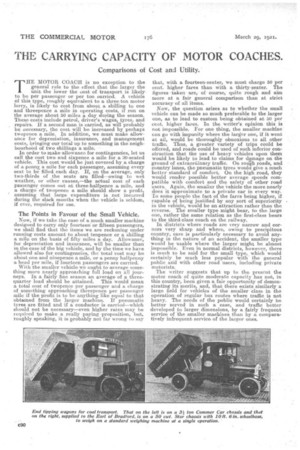THE CARRYING CAPACITY OF MOTOR COACHES.
Page 18

If you've noticed an error in this article please click here to report it so we can fix it.
Comparisons of Cost and Utility.
THE MOTOR COACH is no exception to the general rule to the effect that the larger the unit the lower the cost of transport is likelyto be per passenger or per ton carried. A vehicle of this type, roughly equivalent to a three-ton motor lorry, is likely to cost from about a shilling to one and threepence a mile in operating -costs, if run on the average about 60 miles a day during the season. These costs include petrol, driver's wages, tyres, and repairs. If a second man is carried; as will probably be necessary, the cost will be increased by perhaps twopence a mile. In addition, we must make allowance for depreciation insurance, and management costs, bringing our total up to something in the neighbourhood of two shillings a mile.
In order to make allowance for contingencies, let us call the•cost two and sixpence a mile for a 30-seated vehicle. This cost would be just covered by a charge of a penny_ a mile for each passenger, assuming every seat to be filled each day. If, on the average, only two-thirds of the seats are filled—owing to wet weather, or other causes,—the actual cost of each passenger comes out at three-halfpence a mile, and a charge of twopence a mile should show a profit, assuming that large expenditure is not incurred during the slack months when the vehicle is seldom, if ever, required for use. .
The Points in Favour of the Small Vehicle.
Now, if we take the ease of a much smaller machine designed to carry only fourteesf or fifteen passengers, we shall find that the items we are reckoning under running costs amount to about tenpence or a shilling a mile on the basis of fifty miles a day. Allowance, for depreciation and insurance, will be smaller than Ill the case Of the big vehicle, and by the time we have allowed also for contingencies, the total Cost may be about one and ninepence a mile, or a penny halfpenny a head per mile, if fourteen passengers are carried.
With the smaller vehicle we ought to average something more nearly approaching full load on all journeys. In a fairly fine season an average of a threequarter load should be attained. This would mean a total cost of twopence per passenger and a. charge of something approaching threepence per passenger mile if the profit is to be anything like equal to that obtained from the larger machine. If pneumatic tyres are fitted and if a conductor ia carried—which should not be necessary—even higher rates may be required to make a _really paying proposition, but, roughly speaking, it is probably not far wrong to say
that, with a fourteen-seater, we must charge 50 per cent, higher fares than with a thirty-eeater. The
figures takenare, of course,quite rough and aim more at a fair general comparison than at strict accuracy of all items.
Now, the question arises as to whether the small vehicle can be made so much preferable to the larger
one, as to lead to custom being obtained at 50 per cent, higher fares. In the writer's opinion this is not impossible. For one thing, the smaller maelrine can go with impunity where the larger one, if it went at all, would be thoroughly obnoxious to all other traffic. Thus, a greater variety of trips could be offered, and roads could be used of such inferior construction that the use of heavy vehicles upon them would be likely to lead to claims for damage on the ground of extraordinary traffic. On rough roads, and country lanes, the pneumatic tyres would give a much better standard a comfort. On the high road, they would render possible better average speeds compatible with comfort and the safety of other road users. Again, the smaller the vehicle the more nearly does it approximate to a private ear in every way. To seine people the fact of the fares being higher, if capable of being justified by any sort of superiority in the vehicle, would be an attraction rather than the reverse. The smaller type might bear, to the large one, rather the same relation as the first-class bears to the third-class coach on the railway.
In districts where roads are very narrow and corners very sharp and where, owing to precipitous country, care is particularly necessary to avoid anything in the nature of an accident, the smaller type would be usable where the larger might be almost impossible. Even in normal districts, however, there is much to be said for the small type, which would certainly be much less popular with the general public and with other road users, including private motorists.
The writer suggests that up to the. present the motor coach of qiiite moderate capacity has not, in this country, been given a fair opportunity of demonstrating its merits, and, that there exists similarly a large field for vehicles of the smaller class in the operation of regular bus routes where traffic is not heavy. The needs of the public would certainly be better served in such a case, and traffic better developed to larger dimensions, by a fairly frequent service of the smaller machines than by a comparatively infrequent service of the larger ones.






































